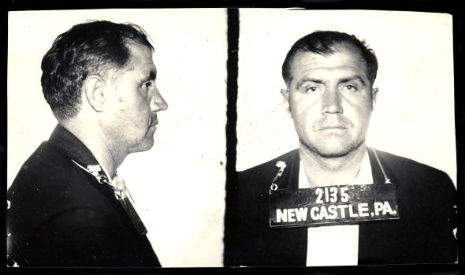
The small town of New Castle, in western Pennsylvania, was once a boom town way back at the start of the twentieth century. Its population had tripled between 1890 and 1900, as immigrants from across Europe and America came to the town in search of employment in its tin plate mills, steel factories, ceramics works, foundries and paper mills.
The 1930’s Depression hit New Castle hard, but its manufacturing base was kept going by WWII and the Korean war. The population peaked in 1950 at 48,834. Since then it’s dropped to around 28,000 today. The boom years are long gone and the unemployment average in New Castle is twice America’s national jobless rate.
The site Small Town Noir curates the mugshots of petty criminals whose lives unraveled in sad, tragic, grim, bizarre and often disturbing ways within the boundaries of New Castle’s borders. Each entry is well-written and the biographical information has been painstakingly researched from various sources.
Small Town Noir is a fascinating place to visit, to while-away a few hours, as you get to know its citizens.
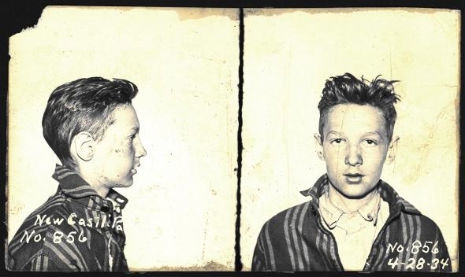
James Dagres, “B & E”, 28 April 1934
James Dagres was sixteen, when he was arrested for breaking an entering. Dagres, together with two chool friends James Cook, LeRoy Shoaff, removed various items from the house—tables, chairs, a gas heater, a clock, a world atlas—and sold them to second-hand dealers in town. They were caught when the owner of the house, a local teacher, passed by and saw them carrying furniture out of the place. All three boys were minors. There is no record of any sentence. When James left school, he got a job at American Cyanamid & Chemical. LeRoy Shoaff went on to become a colonel in the US army. There is no further record of Jack Cook.
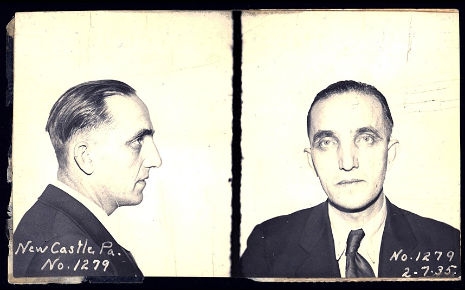
Homer Chrisner, “Bank Holdup”, 7 Feb 1935
Homer Chrisner lost his business during the Depression. A respected figure, borough councilman and pigeon fancier, Chrisner decided to rob a bank in New Castle, as he reckoned it would be the easiest place to rob.
With his his accomplice Edward Scales, aka Jack of Diamonds, a Youngstown barman and numbers writer who had recently been released from prison after serving a sentence for the attempted rape of a minor. Together, they planned the details of the hold-up and enlisted the help of a woman called Nellie Sellers who would act as their getaway driver.
In February, 1935, Chrisner and Scales walked into the bank and held it up. Chrisner lost his nerve and the bank teller pulled his own gun on the pair. Chrisner and Scales absconded in a car driven by Sellers. They were chased and soon arrested. Homwer was jailed for five years.

David Clemons, “Dis. Cond”, 20 Sep 1936
David Clemons was a 28-year-old was arrested for disorderly behavior in 1936. Eight-years later Clemons murdered his father, Wilson Clemons, a minister in the Church of God in Christ, with an axe.
David had a mental age of nine and had recently been discharged from the army in the build-up to the D-Day Landings. Clemons killed his father after an argument over an alarm clock. He was sentenced to life imprisonment, but was moved to Fairview state hospital for the criminally insane, where he remained for the rest of his life.

Nick Flueras, “Intox Driver”, 22 August 1948
Nick Flueras crashed his car into another vehicle.
A city physician determined that Nick was under the influence of liquor but another physician, engaged by Nick himself, said that the symptoms that had been attributed to drunkenness were the effects of shock. The police charged Nick with drunken driving and released him on bail, but the case never came to court. The conflicting evidence made the process more trouble than it was worth.

Anna Mae Craven, “Dis Conduct”, 14 July 1946
Anna Mae Craven was twenty-two years old when she was arrested for disorderly conduct. A year later, she was married to Lawrence Black, a locomotive engineer on the B&O railroad. The marriage lasted less than three months before Lawrence divorced Anna Mae on grounds of immorality and indignities to person.
Lawrence, who never remarried, lived alone in a house in Mahoning township until he fell ill and died suddenly in 1971, at the age of fifty-five. There is no further record of Anna Mae.
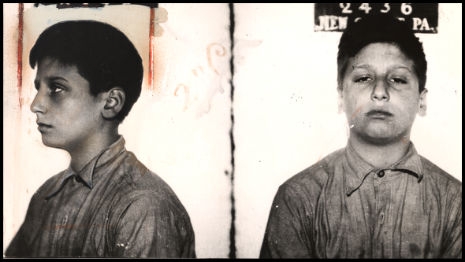
Anthony Naples, “Murder”, 10 May 1937
Anthony Naples was eleven years old when he took his father’s pistol and shot his classmate Robert McDowell, in the face. Robert died in hospital half an hour later. Police found Anthony hiding under his bed at home.
Anthony originally told the police he had been playing cowboys and indians, and had thought the gun was loaded with blanks. Under questioning, Naples admitted he had shot McDowell in retaliation for being hit by him the previous day. Naples said he was the leader of a gang and had shot McDowell as he was black and wanted “to keep the colored folks in line.”
In court he returned to his cowboys and indians story. He was found guilty of manslaughter, and was sentenced to six to twelve years’ supervisory custody. Unaware of the seriousness of his actions, Naples broke down in court and was consoled by his mother.
He was sent to the Elmwood home for boys, in Erie. When it burned down a year later, he went to the Huntingdon reformatory. He was paroled on his eighteenth birthday and moved back in with his parents. A few years later, he was arrested for peeping in windows on Williams street. Just after he turned thirty, he spent three months in the workhouse for stealing and selling a $900 accordion.
Anthony was still living with his mother at the beginning of 1966, when he fell seriously ill. He died in the second week of January. He was forty years old.

Jessie Smith, “Larceny, Disord Cond”, 22 Feb 1932
Jessie Smith moved form the southern states in the hope of escaping the racism. Klan violence, poverty and starvation from crop failure. Smith arrived in New Castle only to find the hotels refused were white-only blacks accommodation. Smith found a room to rent and work at the Vanhorn apartments, a dilapidated three-storey frame building by the bridge over Neshannock creek on South Jefferson street, a well known and frequently raided brothel. She was arrested there one Saturday night in 1918, along with the other girls and four customers. The prostitutes were fined $15; the proprietress, Mary Armour, $50; and the customers, $10. A decent night’s profit for the city.
Smith moved out and worked the “houses” paying an occasional $10 or $15 fine for the privilege. She married Robert Cruthers, who lived off her earnings and beat her when the mood took him. Sometimes, the beatings were so bad that she would go to the police, who would arrest him for assault and battery and give him a $10 fine, which he’d pay using money that Jessie had worked for.
It was typical then of certain white men to exploit the endemic racism in America, by paying for sex with a prostitute and then recouping their money by reporting they had been robbed by a black woman. These complaints often gave the police an excuse (not that it was needed) to raid a brothel. In 1930, Smith was arrested in a raid and charged with stealing some white man’s money. She was fined $10.

Ernest Pokersnik, “B E Larceny”, 7 May 1946
was arrested for stealing scrap. Pokersnik had immigrated as a child with his family from Slovenia. He had served as a mechanic during the Second World War in England.
Pokersnik was caught stealing scrap by Charles L Reese, who had been appointed constable of the third ward when the previous incumbent had been elected to the city council. Reese had been trying to become a councilman since the thirties. His campaign advertisements, printed in the New Castle News every election, listed his virtues. He was always the youngest candidate. He understood the needs of returning soldiers. He had fought in the first world war. He had been posted in Mexico, Panama, the Philippines, China and Russia. He had wide experience of tree surgery and landscaping. His slogan: “If you live in a city, live for it. If you work in a city, work for it.”
Reese told Ernest that, if he gave him $200 and pled guilty, he would use his influence to make sure the judge kept him out of jail. Reese paid him what he asked and did what he said. He got an $85 fine and was sent to the county jail for four to eight months.
At the end of summer, when Ernest got out, he told the district attorney what Reese had done. Reese confessed and was fined $200 and given six months in the workhouse. He never achieved elected office.
Ernest died in 1988, at the age of seventy.

Bill Harlan, “Stick Up, Robbery”, 11 March 1933
Bill Harlan was the seventeen-year-old son of a respected local family, who was arrested after he held up a local inn at the end of a two-month crime spree in March 1933. Harlan had in broke and entered into several local homes, stole jewellery and weapons and robbed a hardware store at gunpoint. Surprisingly, he was spared jail and spent a year in boy’s reformatory.
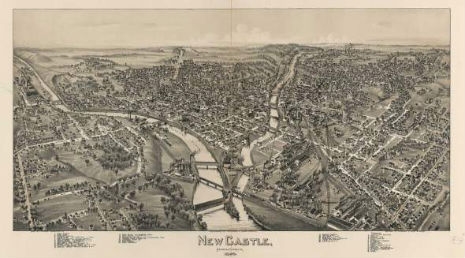
Via Small Town Noir